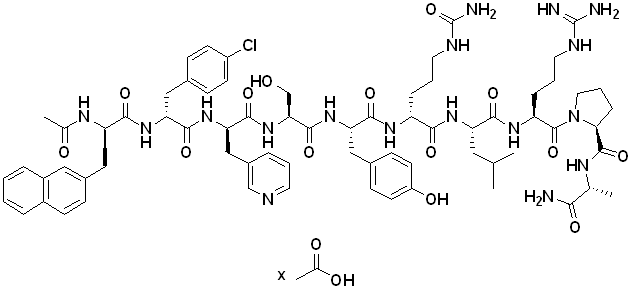Shopping Cart
Remove All Your shopping cart is currently empty
Your shopping cart is currently empty
Cetrorelix Acetate is gonadotropin-releasing hormone (GnRH) receptor antagonist with an IC50 of 1.21 nM.

| Pack Size | Price | USA Warehouse | Global Warehouse | Quantity |
|---|---|---|---|---|
| 1 mg | $40 | In Stock | In Stock | |
| 5 mg | $77 | In Stock | In Stock | |
| 10 mg | $123 | In Stock | In Stock | |
| 25 mg | $263 | In Stock | In Stock | |
| 50 mg | $423 | In Stock | In Stock | |
| 100 mg | $662 | In Stock | In Stock | |
| 1 mL x 10 mM (in DMSO) | $189 | In Stock | In Stock |
| Description | Cetrorelix Acetate is gonadotropin-releasing hormone (GnRH) receptor antagonist with an IC50 of 1.21 nM. |
| Targets&IC50 | GnRH:1.21 nM |
| In vitro | GnRH-I antagonist Cetrorelix inhibited growth of ES-2 cell line only at 1000 ng/ml.?The incubation of ES-2 ovarian cancer cells in vitro with an GnRH-I antibody inhibited cell proliferation in a time and concentration-dependent manner.?GnRH-I may function as an autocrine growth factor in this ovarian cancer cell line [1]. |
| In vivo | Cetrorelix inhibits the activation of hGnRHR and a downstream luciferase reporter gene in murine LTK- cells by the GnRHR agonist [D-Trp6]GnRH (IC50 = 1.2 nM). In vivo, cetrorelix (60 μg per day) reduces tumor volume to 35% of control and decreases serum luteinizing hormone levels by 50% in a human epithelial ovarian cancer mouse xenograft model[2]. |
| Molecular Weight | 1491.11 |
| Formula | C70H92ClN17O14.xC2H4O2 |
| Cas No. | 145672-81-7 |
| Relative Density. | no data available |
| Color | White |
| Appearance | Solid |
| Storage | Powder: -20°C for 3 years | In solvent: -80°C for 1 year | Shipping with blue ice/Shipping at ambient temperature. | |||||||||||||||||||||||||
| Solubility Information | DMSO: 50 mg/mL (33.53 mM), Sonication is recommended. | |||||||||||||||||||||||||
Solution Preparation Table | ||||||||||||||||||||||||||
DMSO
| ||||||||||||||||||||||||||
| Size | Quantity | Unit Price | Amount | Operation |
|---|

Copyright © 2015-2025 TargetMol Chemicals Inc. All Rights Reserved.